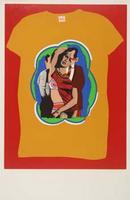 | Peter Blake, "On the Balcony", 1955-7 Peter Blake's oeuvre is sadly very small. His work usually combines different levels or modes of realism in the same work. In this painting, the children are larger, cartoonish, and flatly painted, serving as a ground, really, for the myriad magazine images, which are painted on, rather than being straight collage. The painting is named after the narrow black and white band in the middle of the painting which is an image of the royal family. |
| Archigram,"Seaside Bubbles",1966 Archigram was first a magazine, then an official group. They mined the architectural possibilities of the imaginary structures from pulp science fiction. This must have been anathema to the legions of uber-serious architecture students, who were very earnestly designing scores of drab boxes to honor the living memory of Meis van der Rohe. |  |
 | Allen Jones, "Dream T-Shirt", 1964 An interesting framing device. |
| Malcolm Morley,"Messerschmitt with Spitfire", 2000 Morley started his career in the '60s as a photo-realist, and switched to a neo-expressionist style in the '80s. In the last decade or so, he's synthesized the free compositions of the expressionist work, with the clean approach of his early work, with good results. This is a wall-size painting from a series based on the die-cut papercraft airplanes which used to come on cereal boxes and the like. Morley, as a child, had an airplane crash into his bedroom, in his absence, during the Battle of Britain. The odd patterns on the planes are their because many pilots would give their planes custom paint jobs. |  |
 | R.B.Kitaj, "Autumn of Central Paris", 1972 This is an artist who really has a problem with self-editing. His career defining moment wasn't a painting at all, but was when he cited anti-semitism as the reason for all of the bad reviews of his London retrospective in the '70s. This was in poor taste and alienated a lot of people. Also, I find that his work slides off into neo-expressionist drivel after his early career. That said, I really like this painting. I think it makes great use of a cartoon syntax. It's about the final days of the philosopher Walter Benjamin, author of "Art in the Age of Mechanical Reproduction", who was killed fleeing the Nazis. |
| Pauline Boty, "Tom's Dream", 1963 Pauline Boty mixed large Mattise-cut-out shapes with more illustrative passages to good effect. She unfortunately died at the age of twenty-eight. |  |
 | Patrick Caulfield, "Portrait of Juan Gris", 1963 ... in the interest of weblog continuity. |
Wednesday, August 31, 2005
Brit pop, addenda
In this post, I'll be appending some artists of interest to the discussion of pop art below. Pop art's origins are in Britain, specifically with Richard Hamilton, Eduardo Paolozzi and the Independent Group. Unlike their American counter-parts, these Brit pop artists didn't have a critical figure like a Steinberg or Greenberg to co-opt or codify them. The work when taken together very much reflects the anarchic spirit of youth culture, and the rock and roll of the time. Robert Hughes, in his American Visions series, says that the difference between British and American pop art was that the British were responding to the American popular culture being piped over the sea as a distant oasis, full of possibilities and seperate from the stodgy, conformist society they lived in; whereas the Americans were making Pop art out of nausea or narciscism, as a reaction to Fifth Avenue.
Subscribe to:
Post Comments (Atom)

1 comment:
Some of the Archigram stuff strongly resembles a project Stereolab did with sculptor Charles Long, entitled "The Amorphous Body Study Center"
Post a Comment